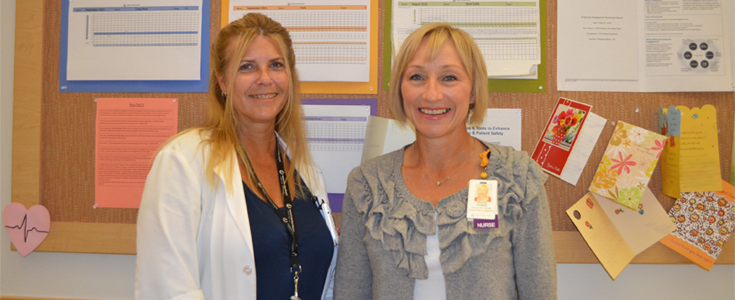
Sandy Warren and Rhonda Findlater at the heart to heart board, the location of powerful conversations.
Finding solutions together
Heart to Heart Daily Management positively impacting patients and employees
Heart to Heart Daily Management is positively impacting communication, employee engagement, job satisfaction and patient safety and satisfaction.
A "heart to heart" conversation - several of them, in fact - is having a really powerful impact on the Cardiac Surgery Inpatient Unit at St. Boniface Hospital.
Improved employee engagement, job satisfaction and ultimately patient safety are the benefits when people not only feel heard, but have an opportunity to share their perspective in contributing to a safe environment for both patients and staff.
It started with a huddle, and the idea was tweaked a bit.
The goals were initially lofty - incorporate lean transformation and continuous daily improvement into an existing well-established huddle format. Over time, they've set the bar even higher to include St. Boniface Hospital's True North metrics: do no harm, manage resources, satisfy patients, engage staff and keep patients flowing.
During heart to heart conversations four times a day at shift change (7:30 am, 3:30 pm, 7:30 pm and 11:30 pm), unit status and challenges are discussed, risks are quickly identified and solutions are recognized and implemented often just as quickly. Little things are being addressed on an ongoing basis and, over time, culture is changing in a positive way.
That's partly because staff is being empowered to not only spot problems, but to speak up about them and find ways to solve them in a systematic way. Heart to heart conversations are led by the charge nurse (or whoever was in charge on the off going shift), are collaborative with all disciplines and often take less than five minutes.
"How do we work with each other, how do we talk to each other?" asks Rhonda Findlater, who was the manager on the unit for 14 years. She is currently the Director of Education and Clinical Programs Support; Lisa Bowen, the current Program Team Manager, has worked on the unit in different capacities for over a decade. "We are working towards getting the front line staff involved in identifying risks and solving problems. People at the front lines know where the issues are and often know the root cause and best way to deal with risks before they turn into problems."
Some issues brought up may be fixed that day, others may take a couple of days while still others are bigger projects that require help.
The heart to heart conversation is located at the visual board across from the main desk and addresses all five metrics while considering elements like falls, medication errors, and sick time. Rules include addressing the issue, not people and there is a strict rule of no blaming.
At one point, says Sandy Warren, Continuing Education Instructor, people are asked to identify risks or recognition.
"It's my favourite part and we've learned so much. The recognition - thank you for doing this - is specific to a person and to a given task and people love it," says Warren. "We're trying to encourage a culture of support and teamwork. Real time feedback on performance lends itself to being able to identify barriers at the time and find solutions to do better or to celebrate and reinforce positive behaviours."
If you're skeptical about the power of regular communication, think again. The numbers tell a very clear story.
This unit has the highest employee engagement in the hospital in the majority of categories. When last surveyed, the unit scored on track with best employers or better at 77 per cent engaged.
"We tried to get the culture going and now that we have momentum, it's only getting better, which is very exciting," says Findlater.
Patient satisfaction rates support this. Patients consistently rate their satisfaction of care received as between 85 and 95 per cent excellent and very good.
"We've immersed staff in the true north metrics; what the goal is, empowered and involved them in problem solving. The result is a better place to work that's safer for patients," says Findlater. "It's exciting to be creating a culture of problem solvers."
Warren notes this perspective gives people a broader view of what they are responsible for beyond specific assignments. It is also creating a more collaborative environment when everyone on the team is working toward shared goals and is aware of the shared challenges facing that shift.
"Developing trusting relationships opens up discussions," says Warren, "and opportunities for conversation are always fabulous. Taking care of each other as well as our patients and their families is part of our job."
